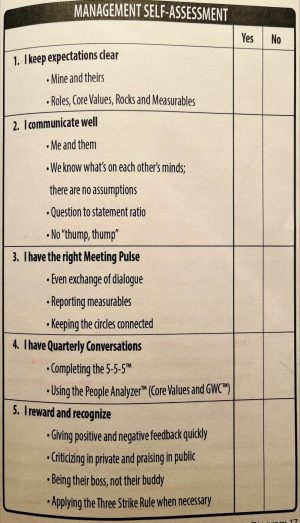Chapter 7 – The Five Management Practices, page 79.
“Effective leadership is putting first things first. Effective Management is discipline, carrying it out.” – Stephen R. Covey
“The moment you feel like you have to manage someone, you’ve made a hiring mistake.” – Jim Collins
Practice 1. Keeping Expectations Clear
- You can’t hold your people accountable until you have clear expectations.
- When you keep your expectations clear, you will rarely have to fire anyone that does not meet them. They will usually quit because they realize they can’t live up to your expectations.
- There are four areas where you must keep expectations clear:
1. Roles
- You must clearly articulate at a high level the work and outcomes for which they’re being held accountable.
- Boil it down to five major roles.
2. Core Values
- You must teach your people the Company’s Core Values so that they know exactly how you expect them to act and make good decisions in your absence.
3. Rocks
- These are the quarterly key priorities (often referred to as goals, objectives, or initiatives).
- You and your direct reports must agree on the one to seven most important priorities that they must complete in the next ninety days.
- Have your direct report work on Rocks that are SMART (Specific, Measurable, Attainable, Realistic, and Timely).
- Set Rocks with your people, not for your people.
- Set Rocks in light of your company’s goals and issues.
4. Measurables
- Also known as metrics or key performance indicators.
- When each person has one or more numbers to measure their performance, it gives them a clear picture of whether or not they’re winning.
- When each person has a number to hit, it is the essence of pure accountability and clear expectations.
- Measurables add a level of objectivity, enabling us to cut through assumptions, egos, opinions, and emotions.
- Think carefully about which numbers could predict success or failure.
- How can we expect to get the most from our people if we don’t provide them with a number(s) that they are held accountable for delivering each week?
Practice 2. Communicating Well
- Now that expectations are clear, communication is vital.
- A great litmus test to prove you are communicating well is that you know what is on each other’s mind. There are no assumptions in the relationship.
- Don’t assume how people are feeling. Ask!!!
- Here are four methods that have helped bosses eliminate assumptions and greatly improve their communication.
1. Two Emotions
- A discipline that will help you avoid making assumptions about how someone is feeling and instead better understand them is called “two emotions.”
- If you are unsure how someone is thinking or feeling, ask!
- “If you could share two emotions about how you are feeling right now, one positive and one negative, what would they be?”
2. Question-to-Statement Ratio
- A great communication discipline is to monitor your question-to-statement ratio when having a conversation with your direct reports.
- Your job is to ensure that the dialogue is 80/20, where your direct report is doing 80 percent of the talking and you’re doing 20 percent.
- You’ll be amazed what happens when an issue is brought to you, and instead of making a “you should have…” statement, you ask a person a question along the lines of, “Knowing what you know now, what would you do differently next time?” Or, “What would you do?”
- Get them to answer the question. They’ll become more independent.
- By asking them what they would do, you are in effect asking them to commit to their own plan.
3. Echoing
- When you are in a situation where you told your direct report something and you’re not entirely certain that they understood you, ask the following question…
- “Just to make sure that I am communicating well, could you please tell me what I just told you?”
- Or, if you’re not sure you understood something they just told you, ask:
- “Here’s what I just heard you say. Did I hear you correctly?”
- These become great opportunities for both of you to restate your message until you’ve eliminated any miscommunication and have gotten yourselves in sync.
4. “Thump-Thump”
- When a person is tapping a song (like “Twinkle, Twinkle, Little Star”) on a table, they hear the song perfectly in their head, but that’s not what the listener is hearing. Instead, the listener is hearing a series of monotone thumps on a table
- When we share a verbal message with direct reports, we assume we are doing a great job of communicating – it’s pitch-perfect in our heads. However, all our direct report(s) are hearing is, “Thump-Thump.”
- The lesson is, don’t assume your message is being clearly received. Ask, “Could you tell me what you heard me say?”
Practice 3. Maintaining the Right Meeting Pulse
- You can leverage effective communication by instituting a rock-solid Meeting Pulse
- We recommend pulling your team of direct reports together every week for sixty to ninety minutes.
- What gives weekly meetings a great pulse is that they are on the same day every week, start at the same time, have the same agenda, and they begin and end on time.
- Each meeting:
- Has an even exchange of dialogue.
- Each person should report measurables and results.
- The team should identify, discuss, and solve issues.
- Watch this video at www.eosworldwide.com/level-10.
- Here’s a sample from the hundreds of excuses that we hear from bosses before they finally commit to a weekly Meeting Pulse:
- I don’t have time for meetings.
- Meetings are a waste of time.
- Meetings are boring.
- We don’t have that many issues every week.
- It’s impossible to get everyone together for a meeting every week.
- I have an open-door policy, so we talk all the time.
- If they need to talk to me, they know where they can find me.
- I meet with my people when necessary.
- What bosses say just a few weeks after they begin a weekly Meeting Pulse:
- We’re communicating better.
- We’re coming together as a team, being more open.
- We are finally solving issues that have lingered for months.
- We are better at doing what we say we will do.
- In total, I am spending less time in meetings.
- We’re getting more things done.
- We’re beginning to hold each other accountable.
- Everyone is being heard.
- I have a better feel for what’s happening and why.
- We’re having more fun.
- The team is more energized.
- My direct reports have a better understanding of our overall goals.
- If you are resisting a weekly Meeting Pulse, we urge you to try it for ninety days and see for yourself.
- Some direct reports may also require one-on-ones. If so, determine the appropriate Meeting Pulse and agenda to ensure that each person receives enough of your time and that your circles stay connected.
Practice 4. Having “Quarterly Conversations”
- To truly manage and continue to improve your relationship with each of your direct reports, you need to connect at a higher level in addition to the weekly Meeting Pulse.
- To do this, you must have a face-to-face Quarterly Conversation with each direct report.
- Conduct the conversation once a quarter because, in our experience, relationships begin to fray and goals tend to get off track about every ninety days. It’s human nature.
- The Quarterly Conversation should focus on what we call “The 5-5-5.”
- We call it the “5-5-5” because there are usually three to seven Core Values, one to seven Rocks, and four to six roles (the average for each is about five).
- Ninety percent of what you expect of your people falls into the categories of Core Values, Rocks, or Roles.
- The objective is to discuss what’s working and what’s not working in these three areas.
Practice 5. Rewarding and Recognizing
- Whether they give a pat on the back or a kick in the butt, great managers reward and recognize their people quickly.
- Studies show that people work harder for recognition than they do for money.
- Don’t underestimate the power of recognition and the effectiveness of feedback, both positive and negative.
- Here are three recognition disciplines that will help:
1. The 24-Hour Rule
- Always give positive or negative feedback quickly, ideally within twenty-four hours.
2. Public and Private Recognition
- As you give positive and negative feedback, you should always criticize in private and praise in public.
3. Boss Versus Buddy
- You must understand the fine line between being in charge and being in the trenches. Don’t cross the line.
- When the line is blurred and you consider them more of a friend, you can never fully apply these practices due to potential hurt feelings, or having to tiptoe around tough issues and dilute the real message.
The Three-Strike Rule
- Sometimes, despite your best efforts to create clear expectations, communicate effectively, have Quarterly Conversations, and provide positive or negative feedback quickly, things don’t work out.
- Your direct report fails to deliver and doesn’t see or admit they are not delivering.
- Prework:
- Make sure expectations were clear.
- IMPORTANT: You should have at least three data points (specific examples) for each issue that you intend to raise during each meeting in the Three-Strike Process.
- Strike One:
- Meet with the person.
- Utilize the People Analyzer.
- Identify the Issue(s).
- Make sure the person acknowledges and agrees that they are below The Bar before determining an appropriate action plan.
- Agree on a course correction.
- Clarify expectations by putting feedback in writing.
- Set a time to meet again in one month.
- Strike Two:
- Meet with the person and review the prior thirty day’s performance.
- Consider having a third-party witness.
- If expectations are still not being met, identify remaining issues, and agree on a plan to address them.
- Put your feedback in writing.
- Set a time to meet again in one month.
- Strike Three:
- If the issue isn’t resolved by the third meeting, terminate them.
- Most will quit before the third meeting.
Management Self-Assessment
- Now that you have a clear understanding of the Five Management Practices, we’ve created a one-page self-assessment so you can do a quick checkup on yourself.

The Five Management Practices – Next Steps
- Schedule a date on your calendar for when you will be able to answer yes to all of your no’s.
- Review this management self-assessment one on one with each direct report immediately. Ask them how you are doing with each of the five practices.

